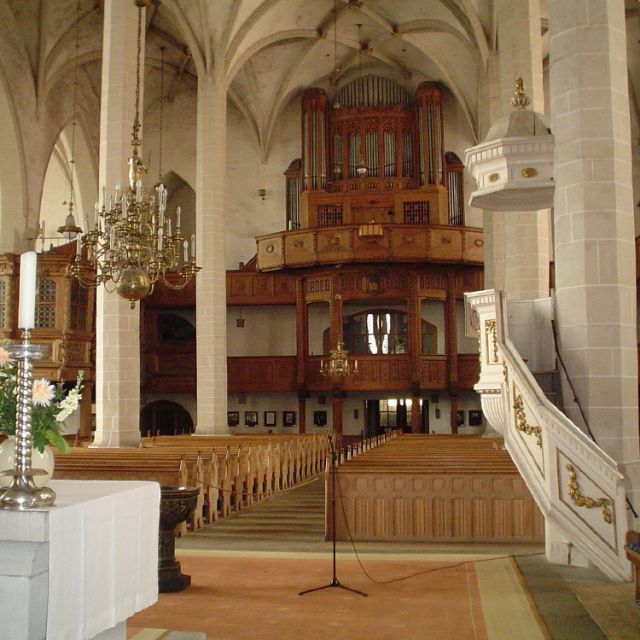The first stop was Bautzen, built on a granite plateau 50 km northeast of Dresden and on the St. James pilgrimage route from Kiev to Santiago de Compostela. To its north is the UNESCO-protected Biosphere Reserve, a 1,000-year-old medieval trade centre that has 17 impressive towers and bastions. The city, high above the River Spree, boasts 1,300 historically important buildings. Its “old town” has been completely renovated within the last 20 years. This area has been home to Germans and Sorbs, the smallest minority of Slavic people who are indigenous to the region, and well known for Sorbic Easter eggs, elaborately decorated and available during the Easter horseback processions here. A Sorbian Language Centre was created here in 2001 to preserve the language.
Saxony’s oldest Christmas market takes place in Bautzen. St. Peter’s Cathedral, built atop the city’s highest elevation (219 metres), is the city’s crowning jewel. The seat of the Catholic bishops of Meissen until 1980, it is East Germany’s only inter-denominational church, divided inside only by a waist-high barrier. There’s an open door for passage. Remarkably, it’s been that way since 1534. The church has two main altars (a Catholic Mass at 9 a.m. and Lutheran service at 11 a.m.), an exquisite vaulted ceiling and two organs, which are a popular part of summer festivals.
Just behind St. Peter’s, fronted by an impressive baroque portal, is the cathedral treasury museum. Most of its artefacts originate from its Catholic heritage. Gotthard Rothmann, treasury curator and former driver for the bishop of Meissen from 1921-80, told me some remarkable anecdotes as we viewed the treasures — a beautiful monstrance, historic depictions of Bernard of Clairvaux and Francis Xavier — such as how a dean of the cathedral became bishop after the original Catholic bishop during the Reformation turned Protestant. It was an exciting walk through some unfamiliar Church history.
Just one hour south, we arrived at Herrnhut, where wealthy Count Zinzendorf rescued a dissident Protestant sect, founded earlier by John Hus in Bohemia. Later known as the Protestant Evangelical Moravian Brotherhood, it sent the first and most dedicated of Protestant missionaries throughout the world. In North America their settlements still are to be found in Winston-Salem, North Carolina, and Bethlehem, Pennsylvania. In Canada, they founded the first Christian mission to the Inuit in Labrador in 1770. Later its medical work was taken over by Dr. Wilfred Grenfell there and in northwestern Newfoundland. In Herrnhut, I toured their simple communal house of worship and unique cemeteries and viewed their distinctive 26-point Advent star, all permeated with their foundational belief “in all things, love.”
Another 30 minutes south I arrived in Zittau, within walking distance of border towns in the Czech Republic and Poland and nestled in the Zittau Mountains. Founded in 1238 by Bohemian King Ottokar II, the town’s development was heavily influenced by cloth weaving, trade in linen and the brewing of renowned beer. However, the most famous assets of this rich trading and culturally diverse town are its textile treasures — the Large Lenten Veil of Zittau of 1472 and another smaller one from 1573. These works are unique in Germany.
The large (56 square metres) Veil, hanging in Holy Cross Church Museum, depicts 45 biblical scenes from the Old Testament and 45 from the New; the smaller one (15 square metres), on display in the former monastery town museum, depicts the Crucifixion. Surprisingly, it was made at a time when Zittau had adopted the Protestant faith. These veils were hung to screen off the sanctuary during Lent. Churchgoers were expected to contemplate the 10 panels containing nine paintings each during Lent.
A horrific event occurred at the end of the Second World War when the largest of these “picture Bibles” was cut up into 11 pieces by Russian soldiers to cover the walls of an open-air sauna in the woods. Providentially, the pieces were saved by a farmer, and after German reunification years later were restored and successfully reassembled. It is only since 1999 that they have been displayed.
(Williams is a freelance writer in Markham, Ont.)
On tour along Germany’s Via Sacra
By Lorraine Williams, Catholic Register SpecialGermany’s province of Saxony is mainly a Protestant Lutheran stronghold. However, I visited one of Germany’s Via Sacra routes. It consisted of three different spiritual centres, situated amongst magnificent scenery, each with a unique religious dimension. Because of this area’s proximity to the Czech Republic and Poland, Catholic ties are strong.
Please support The Catholic Register
Unlike many media companies, The Catholic Register has never charged readers for access to the news and information on our website. We want to keep our award-winning journalism as widely available as possible. But we need your help.
For more than 125 years, The Register has been a trusted source of faith-based journalism. By making even a small donation you help ensure our future as an important voice in the Catholic Church. If you support the mission of Catholic journalism, please donate today. Thank you.
DONATE

